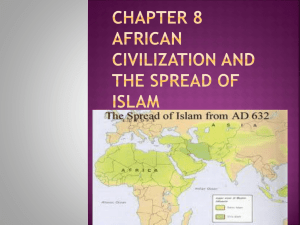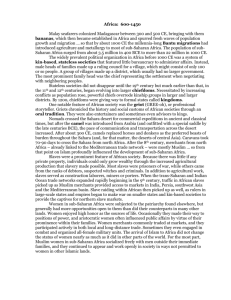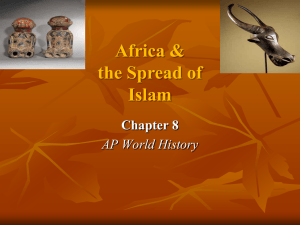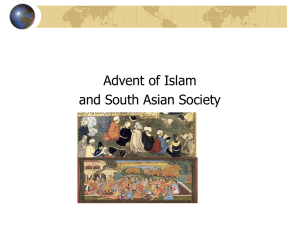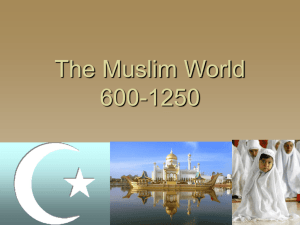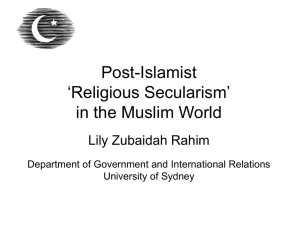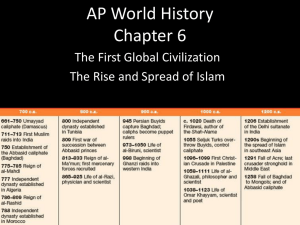Abbasid Decline & Spread of Islamic Civilization
advertisement
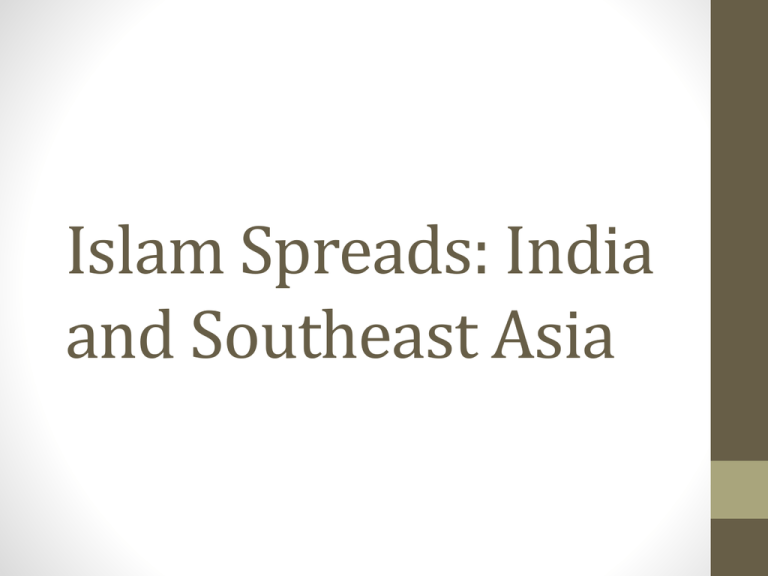
Islam Spreads: India and Southeast Asia Islam in South Asia/India 1st Wave: INVASIONS • 711: Muhammad ibn Qasim conquered Sind region & Indus Valley for Umayyad • People welcomed • • • lower taxes religious tolerance India influenced Islam: Math, astronomy, medicine, music, building styles, Hindu mysticism(?) . 2nd Wave of Invasions • Mahmud of Ghazni- from Afghanistan took India from declining Abbasids • WHY? extravagant wealth of empire • Muhammad of Ghur expanded to Bengal • Sultans established capital at Delhi with a variety of Persian, Turkish, Afghan until 16th century Patterns of Conversion • Islamic conversion was voluntary and peaceful • Sufi mystics attractive to Buddhists, untouchables & low caste groups • Merchant converts improved economic relationships with Muslim traders We see the 3 Ms!!! • Military- Mahmud, Delhi • Merchants • Missionary- Sufi’s and untouchables Muslim v. Hindu • Islam • • • • • • Rigid egalitarian, stern doctrine Monotheistic adopted Hindu styles marriage practices • Hinduism: • Absorptive • supportive of caste system • responded with focus on Bhakti mystic cults • Most showed little interest in Islam Islam & SE Asia • 8th century: Coastal trade (2nd “M”!) dominated by Muslims; 13th century: Collapse of Shrivijaya (SE Asian trading empire) allowed Islam's entrance • Merchants & Sufis (3rd “M”!) brought Islam to Malacca to Malaya & Sumatra; Sufis tolerated earlier animist, Hindu & Buddhist beliefs • Bali & Mainland SE Asia did not convert African Civilization & the Spread of Islam Chapter 8 I. African Societies Pre-Islam • Bantu migration provided common language background • Animistic religion & belief in naturalistic forces; common belief in creator deity • Mixed Economy: agriculture, Active trade & Market Life http://www.google.com/imgres?q=bantu+migration&um=1&hl=en&safe=active&sa=N&biw=1280&bih=840&tbm=isch&tbnid=qHelsCvf9NjTw M:&imgrefurl=http://people.eku.edu/davisb/Africa/Ch7notes.htm&docid=9KQlxftqqoWBjM&imgurl=http://people.eku.edu/davisb/Africa/Bantu migrationmap1.gif&w=405&h=405&ei=xqRYUPu9CMr0iQLl14GYBQ&zoom=1&iact=rc&dur=63&sig=107074975010236596184&page=1&tbnh= 152&tbnw=152&start=0&ndsp=25&ved=1t:429,r:0,s:0,i:76&tx=102&ty=84&surl=1 Arrival of Islam • Between 640-700 Muslim conquered N. Africa; conversion was rapid. Why? • Equality, Political Unity attractive to diverse Africans • Native African Berber Kingdoms emerged in opposition to Arabs. Who? • Almoravids & Almohadis became radical Islamic movement pushing Islam South; used jihadholy war http://www.xtimeline.com/evt/view.aspx?id=36412 Christian Kingdoms Axum, Egypt & Nubia (descendents of Kush) Ethiopia emerged as new Christian dynasty from Axum; struggles between Christian & Muslim persist http://www.google.com/search?hl=en&q=bantu+migration&bav=on.2,or.r_gc.r_pw.r_qf.&biw=1280&bih=840&wrapid=tlif134798651204210&surl=1&safe=active&um= 1&ie=UTF8&tbm=isch&source=og&sa=N&tab=wi&ei=VqRYUKKpBuHWiwKuzYD4Dg#um=1&hl=en&safe=active&tbm=isch&sa=1&q=north+africa+map&oq=north+africa+map&gs_ l=img.1.0.0j0i5l2j0i24l7.8484.11063.11.13907.12.10.0.0.0.1.188.1062.6j4.10.0...0.0...1c.1.yOqCfrwz27g&bav=on.2,or.r_gc.r_pw.r_qf.&fp=fa0fa40884b0c6b7&biw=79 Ghana • There were a number of Sudanic States: Ghana was the first large empire (trade and location) Mali • Economy • Agricultural basis • with active trade (salt, gold, etc) • specialized trading group, juula • Strong legal authority provided easy travel and trade • Politics • Sundiata attained legendary hero status • attributed with social structure; 16 clans of free people, 5 religious clans, 4 specialized clans • Mansa Musa’s Muslim pilgrimage gave Mali recognition & new innovation • Brought renown to Mali • He brought back architect Ishak al-Sahili from Muslim Spain Social and Intellectual • Towns commercial with many foreign residents • Cosmopolitan court of merchants, scholars attracted by power of Sudanic states • Timbuktu- Books were symbol of Islamic African civilization • 80% of villagers lived by farming with intensive labor requiring multiple wives and many children Songhay Kingdom began to form in 7th century; dominated Mali by 1370s • Sunni Ali, excelled as commander and leader, established askia (future Songhay leaders) • Religion -was syncretist fusion of Islam & pagan beliefs that encouraged strict interpretation of Sharia law • How was Songhai defeated? • Songhay ruled until defeated in 1591 by a Muslim army from Morrocco Sudanic States: Ghana, Mali, Songhay • Politics• • • • • Patriarchal Leaders or Councils Sacred Rulers associated with rituals Ruling leaders used Islamic titles like caliph to reinforce position same linguistic/ethnicity All used taxes, military support of conquered peoples • Religion- Islam emerges to reinforce idea of kingship AND leaderships reinforces Islam • Common Religion & Law provided unity • Society • still matrilineal • allowed freedom of movement for women despite Arab restriction • Islam encouraged/spread slavery Swahili Coast Coastal Trading Ports Originally inhabited by Bantu people merchants from M. East, China, India Swahili language & cultural traits mixed with active coastal commerce Islam brought to E. Africa from Indian merchants which facilitate trade relationships; primarily among upper ruling merchant classes
